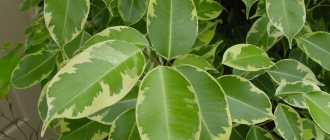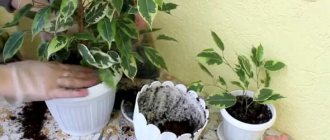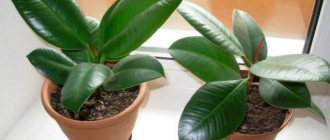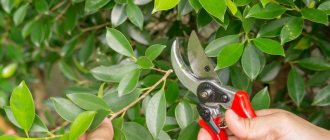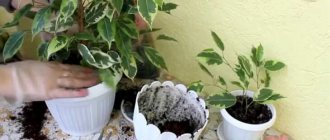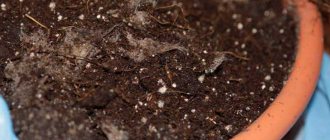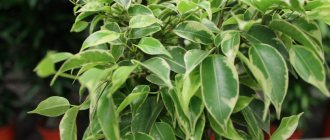Indoor flowers grow in a limited volume of substrate, so it must fully comply with the requirements of a particular culture. The soil for ficuses needs to be loose, easily permeable to water and air. It is also nutritious enough to provide the tree with the necessary substances for root development and growth of green mass. But not so much as to cause shoots to stretch or leaves to drop.
Features of growing and caring for ficus
Ficus is a native of the tropics. The plant needs warmth, good lighting, high humidity and fresh air.
Recommended conditions for its cultivation and care measures are collected in the table:
| Lighting | Good, diffused, needs lighting in winter |
| Location | Western, eastern window sill. Doesn't tolerate change of location well |
| Air temperature | In summer +25…+30°С, in winter +16…+20°С |
| Air humidity | 50–70% |
| Ventilation | Regular access to fresh air and protection from drafts is required |
| Watering | Moderate in summer (2–3 times a week), scanty in winter (1 time a week), warm, settled, filtered rainwater, as the top soil layer dries |
| Spraying | In summer, regular use of warm, settled or boiled water |
| Top dressing | In spring and summer, 2 times a month with nitrogen-containing fertilizers (nettle, mullein, wood ash infusion, “Ideal”, “Gumisol”, “Ficus”, “Palma” fertilizers); not required in autumn-winter |
| Transfer | If necessary, by transshipment method, annually - renewal of the top soil layer |
| Trimming | Sanitary and formative, from the beginning of spring to the first ten days of summer |
Care after purchase
How to care for Ficus Benjamin at home after purchase:
- Place it separately from all other plants for up to 3 weeks . This will make it possible to determine whether there are hidden diseases that can be transmitted to other crops.
- Check the soil moisture - it should be slightly damp.
- The sun's rays should not shine directly on the crown, otherwise the plant will get burned and get sick.
- Do not fertilize or prune immediately after moving the ficus. These plants do not like transportation and can suffer for a long time - up to 6 months.
The best option for caring for Ficus Benjamin would be a location in diffused light with no drafts. A draft is what leads to the immediate shedding of leaves - literally in 2 - 3 days.
Watering
Watering needs to be given special attention. All tropical plants do not like excess or lack of water. A special feature of caring for Ficus Benjamin at home is controlling soil moisture. The next watering is carried out when the soil is almost dry, but not completely.
There should always be water in the pan, but there should be an air gap between the drainage holes and the container. This can be done by pouring a layer of fine expanded clay into a tray and placing a flower pot on it. This technique prevents rotting of the root system and ensures good drainage.
In summer, when the temperature rises above 30 degrees, it is necessary to spray the plant and bathe it in the shower, washing off the dusty film. This promotes better gas exchange and natural thermoregulation of the plant.
Lighting
Varieties with green and dark green leaves should grow in diffused light or partial shade. Variegated specimens are difficult to care for, since they need to be provided with increased daylight hours using phytolamps or fluorescent lighting fixtures.
A place near an east or west window on a stand so that all the leaves receive enough light is the best option. It is not recommended to rotate Ficus Benjamin, especially since you should not frequently move it from one place to another. The plant may respond by falling leaves.
To prevent the trunk from skewing in one direction due to the degree of lighting, the plant is rotated no more than 10 - 15 degrees relative to its previous position. Experienced plant growers advise placing the tub or pot on a stand with wheels in order to discreetly rotate the structure relative to the window.
Location in the apartment
In winter, the plant must be removed from radiators. This is difficult to do, since another wintering option may have worse lighting and the ficus will begin to hurt. If you turn off the battery, the apartment may become noticeably colder. These nuances need to be thought through immediately after purchase, so that you can move the plant less later.
Ficuses are suitable for southern windows, but with a little darkness, as the leaves can get burned and fall off.
In summer, the Benjamin flower can be taken outside or placed in a loggia where there is more fresh air. It is necessary to ensure that the place is dark.
The problem of care is that it is difficult to bathe large specimens - the only option is to spray and wipe the leaves with a damp cloth, which takes a lot of time, since the ficus crown is very thick. It will take about 4 hours to wipe all the leaves .
The optimal summer temperature for Ficus Benjamin is up to 26 degrees. In winter 16 - 18. It is not advisable to keep the plant in the cold during the wintering period. Temperatures that are too low can cause leaves to fall.
Soil requirements
The soil in which it is planted has a great influence on the decorative appearance, growth and development of the ficus.
The following requirements are put forward for the soil for this flower:
- nutritional value;
- good conductivity of moisture and oxygen;
- humidity;
- slightly acidic or neutral pH reaction;
- high drainage layer.
Did you know? Residents of the tropics build bridges from the aerial roots of ficus trees. Such “live” crossings are strong and durable.
Why replant ficus?
The first reason to replant a ficus is to purchase it. The containers in which plants are kept in the store are not intended for constant maintenance and development; they do a good job of protecting the roots during transportation and remain convenient for a very short time. Having brought a flower home, you want to immediately move it into a large pot. Moreover, roots are most often visible from the drainage holes and it becomes clear that the container is clearly small and the substrate is depleted.
There is still no need to rush into transplanting a ficus for the first time - the delicate plant needs to get used to its new habitat. The bush is left in a purchased pot for at least a week to adapt. Removing the roots from the ground will not be difficult - store containers are fragile, if necessary, you can simply cut them.
A lump of earth removed from the container should be carefully crushed or removed by lightly tapping it. Inspect the roots carefully, cutting off dry and damaged areas. Ficus juice has a bactericidal effect, so the cuttings can be treated without any treatment, but the bush can be immediately transplanted into a new, spacious pot.
Why repeat transplants? Here are some good reasons:
- Most ficus plants grow quickly, increase their green mass, and therefore the roots become cramped in the old pot.
- Even with constant feeding, the substrate gradually loses its nutritional value and requires replacement or at least supplementation.
- Salts and harmful impurities from irrigation water are deposited in the soil, which over time makes it unsuitable and even dangerous for plants.
All these reasons inhibit the growth of ficus and can lead to its withering and even death. Therefore, regular replanting is one of the main techniques for caring for it. There are several other factors to urgently replace the soil and transfer the plant to a new pot:
- the old container is damaged or broken;
- pests have appeared or root rot is suspected;
- the soil has become “sour”: it has acquired an unpleasant odor and is covered with a coating.
Still, the process cannot be rushed. Proper transfer to a new container requires preparation. It is worth paying attention to all stages of transplantation, relying on the recommendations of experienced flower growers.
Required soil composition
In order for a flower to be healthy, have large, richly colored leaves, and a lush crown, it must be grown in soil consisting of certain components. The composition of the soil should differ depending on the age of the plant. For young specimens it should be looser, for adults it should be denser.
Young plants need to be planted in a substrate that consists of:
- turf land;
- humus;
- sand;
- peat
Turf is obtained from areas where perennial grasses grow. When humus is added to it, nutritious soil is obtained. Sand and peat are needed as loosening agents to improve water and air permeability of the soil. Expanded clay, coarse sand, and charcoal are also used as disintegrants. These components prevent moisture stagnation and root rotting.
Mature ficus plants will require soil consisting of:
- leaf soil;
- humus;
- sand.
Important! Soil with a clay structure is not suitable for growing ficus plants. It provokes stagnation of moisture, which is detrimental to the plant.
The acidity level of the soil should be within the range of 6.5–7 pH. Acidity is reduced by adding dolomite flour and lime to the soil. Increased by mixing peat.
Good primer and additional components
The classic substrate that many gardeners use was discussed above, but this is far from the only option used by gardeners. There are many other interesting varieties.
Important! The more saturated soil is used for the ficus, the better it grows.
A universal and at the same time concentrated primer is considered to be one that contains:
- light turf soil;
- deciduous soil;
- heavy turf soil.
Many people also add to this composition:
- rotted manure;
- compost flour;
- peat.
If the soil mixture is made for a young flower, then it would be a good idea to pay attention to the elements that should also be contained in the soil.
This:
- charcoal;
- expanded clay gravel;
- charcoal;
- expanded clay
All these components improve breathability. In addition, they are assistants in the absorption of nutrient solutions and excess moisture in the soil. Expanded clay, which absorbs liquid very well, then releases some of it to the roots.
Experienced gardeners note that for ficus rubber and some other varieties, it may also be necessary to use vermicompost produced by earthworms. Vermicompost is both a substrate component and a good natural fertilizer.
The presented element has some other features.
Namely:
- Improves flower survival rate after planting and replanting.
- Speeds up the adaptation period.
- Stimulates flower growth.
Selection of ready-made soil
For planting ficuses, a substrate is usually chosen, the packaging of which bears the inscription “Ficus” or “Palm”.
Almost every soil manufacturer produces such a product. Their compositions are different. As a rule, they contain vermicompost, peat, sand, expanded clay, lime, dolomite flour, other inert fillers that improve the composition of the substrate, and mineral additives.
This soil does not require pre-treatment and is already ready for use.
Famous: “Flower Happiness”, “Seliger-agro”, “Vermion”, “Garden of Miracles”.
Reproduction
Ficus can be propagated in two ways:
- Cuttings are the most common.
- Layering - the formation of a root system on the trunk of a plant.
This species does not reproduce by seeds: firstly, no one has seen ficus bloom at home, and secondly, the seed material will be defective due to the lack of pollinating insects.
The easiest way is cuttings. To do this, you can take a shoot from any part of the plant. It is important that the bark on it be lignified, since green young shoots rot in water. The smallest cutting can grow into a large tree if it is properly rooted and cared for.
How the procedure goes:
- Select a flexible woody shoot with 4 to 5 leaves.
- Cut it off, wash off the released juice and dip it in some kind of root growth stimulator.
- Let dry for 15 minutes.
- Using a sharp knife, cut the cambium along the trunk in the form of a cross, that is, into 4 parts. Insert a wooden toothpick between them.
- Place in damp sand, perlite, peat or coconut substrate.
At a temperature of 20 - 22 degrees, the process of growing roots proceeds quickly. To ensure that environmental conditions have less influence on the condition of the cutting, it is covered with film, a bag or glass. Ventilate periodically to prevent steam from accumulating.
After 3–4 weeks, powerful roots appear. You should wait until the root sections grow to 2–3 cm, after which the plant can be transplanted into a separate container.
The method of propagation by layering is more complicated and requires certain skills from the gardener. It consists of the following:
- You need to select an area on the trunk where the notching will be carried out. These may be side shoots.
- Make a circular cut around the trunk or branch and remove the top layer of bark. Deep layers of wood should not be touched.
- The area is treated with any rooting agent and wrapped in moss to retain moisture.
- Next, the area is wrapped in cling film, leaving a small hole for watering and breathing.
- In a month, the roots will be visible under the film.
- A ficus benjamina seedling is cut below the root tuft and transplanted into the ground.
After separating the seedling, the cut on the mother plant is treated with crushed activated carbon or garden varnish, which can be bought in the store. If you do not separate the seedling, you can grow aerial roots, after which the ficus benjamina will look like a real tropical plant.
Subsequently, the hanging roots will need to be sprayed so that they do not dry out and maintain their decorative appearance. This technique is used by lovers of the bonsai style.
Interesting! Rubber-bearing ficuses reproduce by aerial roots. In this case, the mother plant could die several million years ago, and its cuttings are still growing and forming new plants
To get many cuttings at once for planting in one pot and weaving trunks, it is recommended to root everything after decorative pruning.
How to make soil for ficus with your own hands?
Many gardeners prefer to make the substrate for planting their flowers with their own hands. In this way, it is possible to control its composition and saturate it with exactly those substances that are necessary for a particular species at a certain stage of development. The disadvantage of preparing the soil mixture yourself is the laboriousness of the process. Some ingredients are not always and not available for sale everywhere.
Important! Soil prepared with your own hands is subject to mandatory disinfection. It needs to be poured with a solution of potassium permanganate or calcined in the oven (microwave) at a temperature of +90...+100°C.
The composition of the soil will differ depending on the type and age of the ficus. Here are recipes for popular indoor species.
For rubber and microcarp:
- Combine equal parts of leaf soil and turf.
- Add half of the river sand.
- Use broken bricks and small pebbles as drainage.
- Cover with a layer of sand on top.
For Benjamin:
- Mix leaf soil, humus, and peat in equal proportions.
- Add river sand and small pebbles.
- Mix everything well.
- Place drainage from a layer of expanded clay and a layer of sand at the bottom of the pot.
How to plant a plant in the soil?
The optimal time to transplant a ficus is spring, since the plant has time to adapt before the onset of cold weather. In autumn and winter, such a procedure is permissible only in emergency cases, when:
- specimen diseases;
- damage to the pot;
- proliferation of pests in the soil;
- or the appearance of an unpleasant odor.
Transplanting a ficus into the soil will involve several steps:
- Selecting a suitable container (to make the flower stable, it should be as heavy as possible).
- Lay out the bottom of the pot with a layer of drainage with a height of at least 2 cm, then pour in the soil mixture:
- for an adult plant - ½ capacity;
- for a young person - almost to the top.
- Form a depression in the soil, place the flower in it and cover with the remaining soil.
- Water thoroughly and drain the remaining moisture from the pan after 15-20 minutes.
Attention! Adult specimens are most often transplanted by transshipment together with an earthen clod.
The root collar should not be allowed to go deep , otherwise the ficus will begin to rot.
Ficuses are relatively unpretentious plants that can fit into any interior. Transplanting and caring for them is not accompanied by any difficulties and can be done even by inexperienced flower growers.
Signs of incorrectly selected land
With improper care or an unsuitable microclimate, the plant will experience changes in appearance.
If the soil is not suitable for him, then this can be recognized by the following signs:
- change in leaf color;
- falling leaves;
- infection by fungus gnats.
If such problems arise, the flower must be transplanted into new soil made up of the right ingredients.
Fungus gnats are destroyed by insecticides: “Decis”, “Aktellik”, “Agravertin”, “Aktara”, “Intavir”. Did you know? The oldest ficus grows in Buenos Aires. It was planted in 1781. It was given the name Homer's Tree.
If you are one of those who likes to keep indoor plants and decide to plant a ficus, you need to provide it with the kind of soil that nature intended for it. Ficus will not require much attention. Even those who grow a flower for the first time can handle its planting and care.
Growing in nature, conditions
In nature, ficus trees grow up to 20 meters, do not shed their leaves, sometimes bloom and form inedible fruits - syconia. Ficus trees include figs or fig trees - their fruits are suitable for human consumption and are grown on an industrial scale.
Many owners of adult plants are interested in whether ficus blooms in the apartment. Flowering in nature is regular. At home, ficus does not bloom and grows much more slowly - with good care, the plant can grow up to 2.5 m.
The flowers are small white peas, so they do not produce any special effect, they simply say that the plant is doing well in these conditions. For flowering, Ficus Benjamin requires some types of tropical insects that do not live in the middle zone.
Signs and superstitions
Sometimes completely opposite properties are attributed to the plant. For example, in some countries he is considered a husband-wife, capable of getting rid of even an existing boyfriend, while in others, on the contrary, he is considered the keeper of the hearth.
It is interesting that for some reason such superstitions always concern only women, and no one tries to protect men from plants that can ruin their personal lives.
We advise you not to listen to any signs and grow this unpretentious plant in your home, which will take root even among inexperienced gardeners.
Optimal lighting, temperature and humidity
In order to decide where to place the rubber ficus, you need to know three facts about this plant.
- Direct sunlight is contraindicated for it - ficus loves bright, diffused light.
- The optimal temperature for the plant is 20-25°C. In the summer heat, ficus can withstand up to 30°C, and in winter it can withstand up to 15°C. But the plant will not be able to remain in such conditions for a long time.
- Elastic loves moderate air and soil humidity. When there is an excess of moisture, the plant sheds its leaves and slowly withers.
Where to put
You should choose a suitable location so that there is enough light for the plant itself and the interior of your home is complemented by this plant.
-Ficuses need lighting all year round, so ficuses have chosen places where the light is diffused, for example: an eastern window sill.
- the temperature that is in the room is suitable. In winter, the temperature is 10 degrees, which is the minimum limit.
-humidity can be increased by regularly spraying the ficus or using air humidifiers. The best way is to wipe the leaves with a damp cloth.
Pests and diseases
If certain plant maintenance conditions are violated, difficulties may arise. The plant begins to look bad and hurt. Pests can also cause damage. Basically, in all types of ficus, problems begin with the leaves.
Withering of rubber ficus leaves may indicate insufficient watering. To do this, you can place the pot in a container of water for an hour, and then allow the excess moisture to drain.
-pests cause significant damage to your plant. Therefore, we always conduct and analyze the appearance. The main pests that can cause significant damage to your ficus are spider mites. A thin web forms on the plant, especially on the leaf petioles. This is a clear sign of a plant being damaged by spider mites. If the infection is only in the initial stage, you can increase the humidity for prevention and treatment. If pest damage has already occurred, we use appropriate pest control products. For a more effective effect of the drug, after treating the plant, put a bag on it for a day, this will enhance the effect of the drug.
-diseases are mainly associated with improper watering of the plant. Leaves may turn yellow and fall off. This may be the result of excess moisture, lack of light, or nutrients. The soil should have time to dry out between waterings. If these signs do not disappear, you should move the ficus to a brighter place, reduce watering and allow the soil to dry well, and fertilize it. Use additional lighting.
Violating the watering regime, excess moisture due to poor drainage or lack thereof can lead to rotting of the ficus. If root rot appears, try drying the plant and treating it with special preparations against fungal infections. Stem rot may also begin. If you miss this moment, it is practically difficult to save the plant.
How to propagate?
Propagation can be done in several ways: seeds, cuttings or leaf propagation.
Hybrid varieties are best propagated vegetatively - by rooting cuttings, for example, by cutting off the top during formative pruning.
ATTENTION: Whatever part of the plant is used as a cutting, it is important that it has leaves before roots form.
In order to root a leaf, it is placed in water (1-1.5 cm at the bottom) until roots form. To speed up and increase the likelihood of rooting, stimulants (heteroauxin) or willow water are used.
Willow branches are rooted in a separate container; the water is not poured out, but plant cuttings are placed there. As it evaporates, add plain water, but do not change it completely.
IMPORTANT: It is impossible to propagate ficus with a leaf without part of the stem. It will take root, perhaps even begin to increase in size, but it will not release a shoot.
Growing problems
- If the leaves of the rubber ficus fall off , there are unfavorable growing conditions: insufficient watering or overwatering, draft or cold, lack of light.
There may be rotting of the root system.
- If the leaves of a ficus turn yellow and fall off , this is a frequent sign of a lack of humidity and high temperature for the plant. in summer this happens if the flower is in the heat, in winter - next to heating devices. It may also be a sign of a lack or excess of nutrition, incorrectly selected fertilizer, or problems with roots.
- Ficus leaves turn black - the most likely reason is flooding of the plant, and, as a result, rotting of the roots.
- White spots appeared on the ficus leaves - a sign that the ficus was exposed to hypothermia. To prevent the appearance of new spots, the flower must be immediately removed from the draft and moved to a warmer place. Damaged leaves do not recover and fall off over time. Keeping a ficus in a cold (below +15o) room for a long time quickly leads to the death of the plant.
- Brown spots on ficus - dry areas on the leaf are formed due to damage - sunburn, damage by insect pests, in particular thrips.
More information about ficus diseases and problems in growing can be read in a separate article Diseases and pests of rubber ficus
Ficus is undoubtedly a useful plant, a champion in purifying the air from harmful substances : phenol, benzene, trichloroethane, as well as various types of bacteria and microorganisms . Thanks to these qualities, ficus improves the health of the air, which has a positive effect on the health of its owners and reduces their risk of a number of diseases.
In its homeland, ficus is widely used in folk medicine to treat many diseases.
The medicinal properties of ficus are also recognized by official medicine . Preparations are prepared from ficus to eliminate benign tumors and to treat pulmonary and musculoskeletal diseases. Ficus copes well with a number of skin diseases, accelerates the healing of wounds and burns, and cosmetics are produced on its basis.
In India, certain types of ficus are used in Ayurveda .
! It should be remembered that there are many types of ficus and their use for treatment is different.
But at home, without having the necessary knowledge, it is not recommended to use ficus for treatment.
The juice of the plant in its pure form can cause skin irritation and an allergic reaction.
Also, it is not recommended for people with asthma to stay in close proximity to the rubber ficus for a long time - the secretions of the rubber ficus are intense and, in some cases, can cause difficulty breathing (this only applies to this type of ficus!).
Ficus is an energetically strong plant that affects the house and its inhabitants in the most positive way.
Ficus cleanses the energy of the house, neutralizes negative emotions , anger, fear, anxiety, and reduces stress.
Indian tradition considers the ficus to be a family tree , the guardian of family happiness, promoting pregnancy and the birth of healthy children.
According to Feng Shui, oval ficus leaves are a sign of wealth , and a densely leafy healthy plant is an undoubted companion to prosperity. The best place for such “money” plants is the eastern side. The main thing is that all conditions for normal flower growth are met.
If we consider ficus as a plant for decorating and landscaping the interior, then it can be placed in almost any room, including the bedroom and office space.
! If there are children and pets in the house, then you need to remember that the sap of this type of ficus can cause irritation and place the ficus so that children and animals do not get to the flower.
Ficus rubbery in the interior
There are many varieties and types of ficus , often so different that it is difficult to discern a relationship between them. But they all have in common a beautiful appearance, fast growth, unpretentiousness and ease of care. All that remains is to choose your flower from all the variety of ficuses.
Rate this article if it was useful to you.
Share the article with your friends.
Share link:
Rate the article!
[Total: 1 Average: 5]
Landing Features
The money tree is a prominent representative of the genus of succulents and belongs to the Crassulaceae family. The plant has a tree-like trunk and a rounded crown
For the normal development of the fat plant, it is important to choose the right soil. In this case, the leaves of the plant will acquire a rich dark green color with a reddish tint, will be dense and fleshy, and the plant itself will quickly adapt to new conditions and will have a healthy appearance.
The process of planting a fat plant cannot be called complicated, but it requires compliance with some mandatory rules and has characteristic features. An important stage in planting Crassula is the creation of good drainage, which is responsible for maintaining soil moisture at the required level. When planting Crassula, you can use the following materials as drainage:
- ceramic shards, brick chips, gravel and crushed stone are natural materials that everyone can have at hand;
- agroperlite, special expanded clay, vermiculite are special products that are offered in flower shops;
- polystyrene foam is excellent for drainage, moreover, this material protects the ground from the cold.
It is important not only in what soil the Crassula will be planted, but also in what pot. To choose the right container for planting, you need to follow some simple tips.
Due to the considerable weight of the plant, it is better to choose a ceramic or clay pot
The weight of the container will balance the heavy plant, and the entire structure will be more stable. Feng Shui lovers should pay attention to pots of red, gold, brown, silver, and black. The superficial location of the roots requires choosing a low but wide pot. The diameter of the container should correspond to the crown of the plant
If the crown exceeds the diameter of the pot, then it is time to replant. The bottom of the container must have drainage holes. Otherwise, the plant may die in a short time.
When everything is prepared, you can start relocating the plant.
Crassula should be planted carefully as it is actually very fragile. Don’t be confused by the thickness of the leaves and branches: the money tree is easy to injure, especially during transplantation
- The plant is removed from the old container. To do this, you need to grab the tree by the trunk and pull lightly. This way, it will be possible to preserve the root system and leaves.
- The old soil is shaken off a little from the roots of the money tree. There is no need to remove it completely.
- The roots cannot be straightened. The plant is immersed in a new pot and located in its center.
- Crassula is sprinkled with prepared soil on all sides. It should not be compacted; it is better to add a new one when, after watering, the soil in the pot settles down on its own.
- At the end of planting, the plant is watered abundantly and irrigated with settled water.
To learn how to properly replant a money tree, watch the video below.


